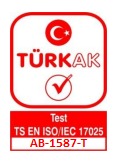Low Pressure (Altitude) Test
MIL-STD-810 F/G/H — RTCA DO 160 G — AECTP -300

İrtifa Testi , ürünlerin ve sistemlerin yüksek irtifa koşullarında düşük hava basıncına maruz kaldıklarında performans ve dayanıklılıklarını değerlendirmek amacıyla uygulanır. Bu test özellikle havacılık, savunma ve elektronik sektörlerinde kritik öneme sahiptir.
Amaç:
- Düşük hava basıncı, sıcaklık değişimleri ve oksijen seviyelerinin ürün üzerindeki etkilerini doğrulamak.
- Sızdırmazlık, yapısal dayanım, soğutma sistemleri ve fonksiyonel çalışma kabiliyetini test etmek.
Test Kapsamı:
- Yüksek irtifa (düşük basınç) simülasyonları
- Ani basınç değişimleri (hızlı tırmanış/iniş senaryoları)
- İrtifa + sıcaklık kombinasyonları (yüksek irtifada düşük sıcaklık koşulları)
Teknik Uygulama:
Düşük Basınç / Yüksek İrtifa Testi esnasında, Yüksek İrtifa Test Kabinimiz ile dış ortam arasında kesinlikle hava giriş/çıkışı olmaması gerekmektedir. Bu nedenle test edilecek numunenin tüm arayüzleri (haberleşme, güç kabloları vb.) kabin yan portlarından hermetik geçiş ile laboratuvar ortamına aktarılmaktadır. Bu sayede test sırasında fonksiyonel testler güvenli bir şekilde gerçekleştirilmektedir.
Uygulama Alanları:
- Uçak ve helikopter bileşenleri
- Elektronik cihazlar
- Yakıt ve basınçlı kap sistemleri
- Savunma sistemleri ve mühimmat
STEST olarak, MIL-STD-810 standardına uygun düşük basınç / yüksek irtifa testlerini ileri teknolojiye sahip test kabinlerimizde gerçekleştirmekteyiz. Test süreci boyunca ürünleriniz uluslararası standartlara göre değerlendirilir ve ayrıntılı raporlar sunulur.
Standards and Methods
- MIL-STD-810F Method 500.4
- MIL-STD-810G Method 500.5
- MIL-STD-810H Method 500.6
Enviromental Test Chamber Specifications
|
|
Altitude Cabin |
Measurement unit |
|
Chamber Length |
2000 |
mm |
|
Chamber Diameter |
1400 |
mm |
|
Minimum Temperature |
-54 |
°C |
|
Maximum Temperature |
+80 |
°C |
|
Altitude Altitude |
0-70000 |
Feet |
CONTACT BY EMAIL
[email protected]
VOICE COMMUNICATION
+90 (312) 905 06 90

STANDART KONTROL VE TEST HİZMETLERİ A.Ş.

